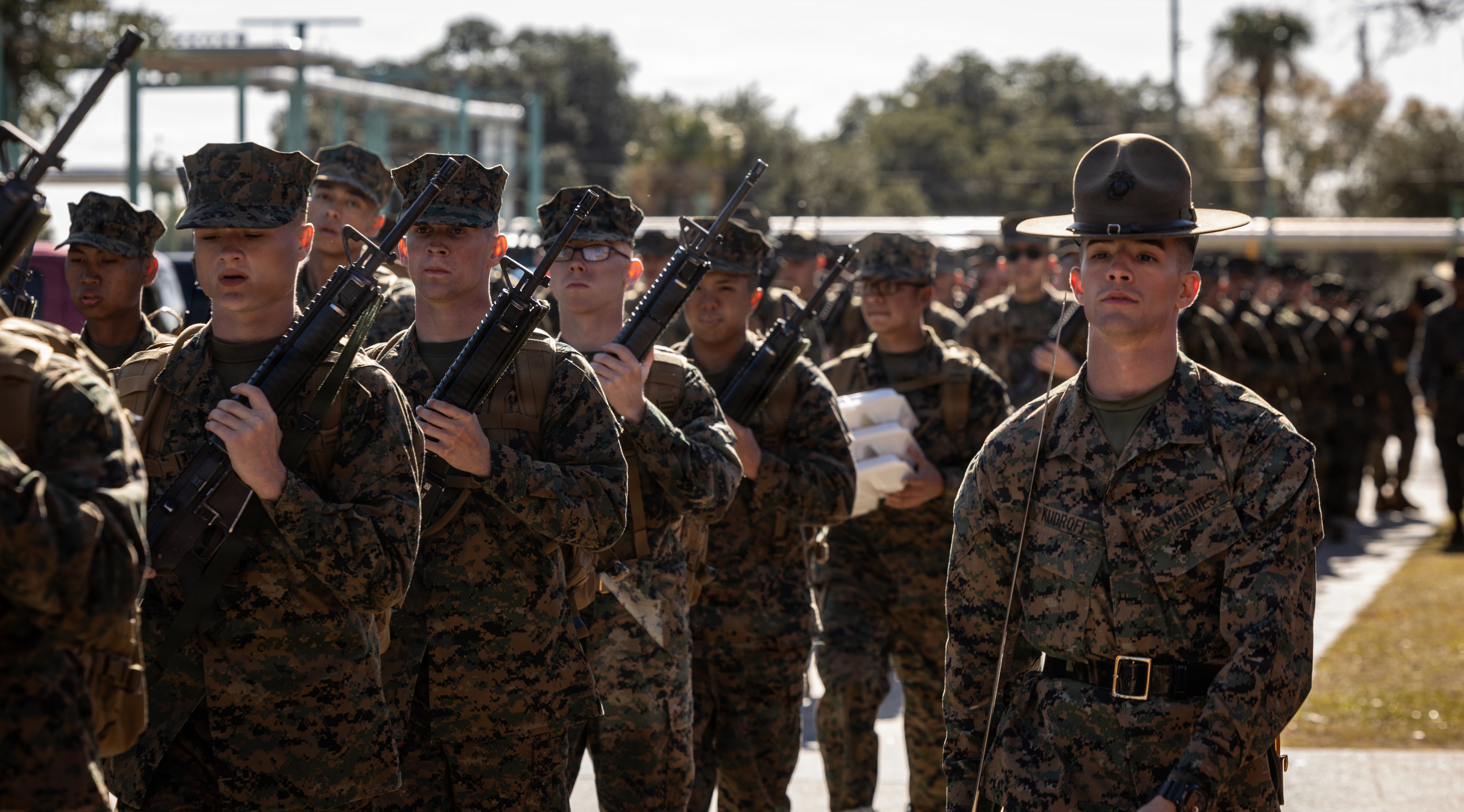If you don't wear a tie to work every day — or you do, and you don't mind looking like a college kid — this backpack can work as a great daily briefcase, especially if you're commuting by train or bus. Pockets, sleeves and admin pouches secure loose papers, folders, pens and just about anything else, plus the dedicated laptop case is ideal for the expeditionary office drone. At 1850 cubic inches, it's also large enough for a few gadgets or gym clothes.
If you’re getting ready to ship out to the sandbox, or looking for something to take on a hike across Death Valley, this may not be your first choice. The Urban Assault isn’t designed to accept CamelBak’s trademark suck-tube water pouches hydration bladder, instead setting aside two side pockets for its flip-up tube, Better Bottle water bottles.
Let's take a closer look at the bag to see if it's got what you're looking for.
[nggallery id=76]
Design
The Urban Assault backpack is a standard heavy-use backpack, with two thick, comfortable shoulder straps with D-rings and removable sternum and waist straps. It has a padded back that lifts the bag slightly to let air circulate, and I found the back-sweat situation manageable even when I wore it in Iraq and Afghanistan. There are extra web loops on the main shoulder straps, which can be used to secure the chest and waist clips if you don't want to use them.
At first glance the shoulder straps look plain and uninteresting. But looking closely you'll notice the shoulder straps are made from two different black fabrics sewn over the shaped foam pad. The softer contact fabric wraps around the padding and is stitched in the front to a strip of heavier fabric that runs on the front. The's strap-mullet means the back of the strap is comfort while the front of the strap takes the weight. It's an elegant and efficient design that shows just how much thought went into this pack, and why it's so expensive.
The bag has three large cargo pockets and one sleeve designed for a laptop. Two of the pockets have a light gray interior, which makes your gear stand out. The outer-most pocket, which has a black interior, has an accordion fold on either side that lets it expand, if needed, making it a good place to put a helmet or a folded up jacket. There are straps on either side that extend to the front of the bag to fasten the outer pocket in place, if you want a squared-away look.
The next inside pocket includes slots, loops and compartments for pens, keys, cards and other items, as well as two smaller zippered pockets to segregate small items. I found the outer zippered pocket, which has a see-through mesh wall, good for carrying my BlackBerry and its charger.
The next inside pocket is the largest, just big enough for a pair of gym shoes and PT gear, or several books and folders. It has its own small, zippered pocket on the forward side, lined with a soft material that makes it a natural place to store sunglasses. The back of the pocket has a net, which can capture loose papers.
The backpack's last inboard pocket is designed for a laptop, lined and sewn such that your computer doesn't touch the ground when you set the bag on its bottom end. The mouth of the laptop pocket will be almost too narrow for 15 or 17-inch machines, and there is no place in the laptop compartment for your computer's power brick. But the bag also has a pocket on either side designed to accept CamelBak's 75mL or 1 liter Better Bottles — one 75mL bottle comes with the bag — and you can use the unused pocket for your power brick.
The space for those bottles takes the place of a compartment for a CamelBak hydration bag and its suck-tube, giving you a maximum of 2 liters of water in two bottles, carried one to a side.
A final, small, lined pocket on the top of the bag is set aside to accommodate an iPod, although it doesn't have a slit to run headphones through so you can listen to music while the player rides in your bag. That was fine with me, but the listen-and-carry feature appears on other bags you see these days.
According to CamelBak, the bag has a volume of 2,000 cubic inches, or 33 liters. It's 20.25 inches tall; 12.5 inches wide; and 7 inches deep.
Construction
The Urban Assault is built rugged, formed around a stiff plastic skeleton that holds its back and straps in place. Each of its zipper tracks is metal, with a metal pull attacked to a nylon cord and covered by a sturdy tube. The bottom of the bag has a broad, heavy panel that helps it stand up. The laptop compartment features a waterproof zipper track, and the iPod pocket also has a cover flap to keep out moisture. It zippers are made by YKK.
The bag has no reflective panel for bicyclists, but there is a Velcro panel on the outer edge of the bag where you can attach one, or any Velcro patch.
Daily Use
CamelBak's Urban Assault bag is optimized for office-workers and commuters, and the bag works just fine for taking a computer and work supplies to and from the office. Because I don't need to carry a laptop every day, I wouldn't use it to replace my leather attaché case, which better handles files and papers, and better goes with ties-and-wingtips office attire. But next time I jet off to a far-flung assignment or embark aboard a Navy warship, I would pick the Urban Assault over the Samsonite travel briefcase I normally use. The CamelBak has much more room and makes it easier to handle the weight of a laptop with lots of other miscellaneous gear.
In addition to a coffin-sized suitcase for clothes, I took the Urban Assault in August on a two-week trip to the Central Command area of responsibility. Here's what I carried in the backpack:
A laptop computer; its power cable; an ethernet cable; four reporter's notebooks; my iPod, its headphones and its charger; two paperback books; my Nintendo DS and two games; two folders for receipts and loose pages; a small digital camera in a case with an extra battery and charger; a Mini-Maglite AA flashlight; my Leatherman Wave; five pens and one mechanical pencil; business cards; my BlackBerry and its charger; earplugs; power adapters for all of the above; and, occasionally, my red Washington Nationals baseball cap, when it wasn't sunny in the sandbox.
The bag swallowed it all, although carrying all that gear gave it a decided roly-poly appearance.
Adjustability
I found it easy to adjust the straps, loops and pockets to my liking on the Urban Assault backpack; the chest and waist straps folded away when I didn't want to use them. The bag is designed to ride high on your back, so even if you let some slack into the bottom of the straps, the design is meant to keep it from sagging off your shoulders.
Looks
With its sophisticated straps and attachments, sleek black color and CamelBack winged skull logo, the Urban Assault is a sharp-looking bag. It was distinctive enough that I easily was able to pick it out of every pile of luggage during my trip through CentCom. If you're traveling to the sandbox, however, be aware that the black exterior will pick up and retain sand and dust for a long time, making the bag start to look worn even when it's new. Almost a month after coming back from Afghanistan, the backpack I tested still was wearing a thin layer of Kandahar grit.
Problems
The retention straps that are supposed to keep secure the bag's outer expansion pocket don't secure well themselves. They're designed to fold inside the expansion pocket, but the clips and the straps flop easily back out again, then rattle and create a scraggly appearance. And if you don't have something like a sweatshirt to stuff down into the expansion pocket, it can seem like a lot of wasted space. Instead of a compartment that admits water and dust, CamelBak could've added another pocket for electronic gear, Faberge eggs, or something else you'd want to carry more securely.
Although you might see it in a catalog photo with the hydration tube, the Urban Assault is one of the few, if not the only pack in the Camelbak line that isn't a true hydration pack. We suspect that the confusion arose because Camelbak may have chosen to market the pack as "hydration capable" in their successful bid to get on the shelves with the rest of their brand at AFFES.
Consider that using a hydration bladder forces you to sacrifice rear sleeve space for your laptop — a deal-breaker for this professional scribbler — and second, it would make what can become a very heavy backpack even heavier. When you have the Urban Assault loaded down and you're carrying one or two full Better Bottles, the last thing you want is another several pounds' worth of water on your back, anyway.
But, if you persist, be advised the Urban Assault backpack doesn’t have an attachment point in its laptop compartment to hang a hydration bladder. If you try to carry the pouch into the laptop sleeve, it will slide around and ride on the bottom of the bag. The backpack I tested also had no slit through which to feed a suck-tube hydration tube, so you’d have to keep the zipper on top of the compartment partly open to rig the tube onto one of the shoulder straps.
Value
The CamelBack Urban Assault backpack costs around $152, depending on the vendor, and a larger "XL" version of the bag — which has the same features as the one I tested but in a slightly larger size — costs $163. According to the company, it's assembled in the United States from U.S.-made and imported components.
Cranky guest reviewer and Navy Times Staff Writer Philip Ewing flogged the Urban Assault on warships, military aircraft and tactical vehicles for two weeks in the Central Command Area of Operations. With the exception of marine gas turbines and phased array radars, he does not like anything.





